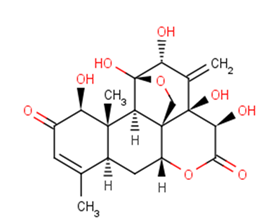
EURYCOMANONE
CAS No. 84633-29-4
EURYCOMANONE( —— )
Catalog No. M19172 CAS No. 84633-29-4
Eurycomanone is cytotoxic on HepG2 cells by inducing apoptosis through the up-regulation of p53 and Bax, and down-regulation of Bcl-2.
Purity : >98% (HPLC)
 COA
COA
 Datasheet
Datasheet
 HNMR
HNMR
 HPLC
HPLC
 MSDS
MSDS
 Handing Instructions
Handing Instructions
| Size | Price / USD | Stock | Quantity |
| 5MG | 82 | In Stock |


|
| 10MG | 133 | In Stock |


|
| 25MG | 284 | In Stock |


|
| 50MG | 428 | In Stock |


|
| 100MG | 521 | In Stock |


|
| 200MG | Get Quote | In Stock |


|
| 500MG | Get Quote | In Stock |


|
| 1G | Get Quote | In Stock |


|
Biological Information
-
Product NameEURYCOMANONE
-
NoteResearch use only, not for human use.
-
Brief DescriptionEurycomanone is cytotoxic on HepG2 cells by inducing apoptosis through the up-regulation of p53 and Bax, and down-regulation of Bcl-2.
-
DescriptionEurycomanone is cytotoxic on HepG2 cells by inducing apoptosis through the up-regulation of p53 and Bax, and down-regulation of Bcl-2.Eurycomanone has anti-cancer activity, inhibits A549 lung cancer cell proliferation in a dose-dependent manner at concentrations ranging from 5 to 20 μg/ml.
-
In VitroEurycomanone (EN) significantly increased testosterone production dose-dependently at 0.1, 1.0 and 10.0 μM, but the two lower doses when combined with 3-isobutyl-1-methylxanthine (IBMX), the phosphodiesterase inhibitor were not significantly higher than EN or IBMX alone, except at a higher concentration. The molecular docking studies indicated EN and IBMX were binding at different sites of the enzyme. EN has no reversal of inhibition by aminoglutethimide, ketoconazole or nifedipine at the respective steroid oogenesis enzyme. The quassinoid was also non-responsive to the inhibition of oestrogen receptor by tamoxifen, but displayed improved for mestane inhibition of aromatase in reducing oestrogen production. The molecular docking studies further supported that EN and formestane bound to aromatase with similar orientations and free energy binding values.
-
In Vivo——
-
Synonyms——
-
PathwayOthers
-
TargetOther Targets
-
Recptor——
-
Research Area——
-
Indication——
Chemical Information
-
CAS Number84633-29-4
-
Formula Weight444.43
-
Molecular FormulaC20H28O11
-
Purity>98% (HPLC)
-
SolubilityIn Vitro:?DMSO : 16.67 mg/mL (40.82 mM)
-
SMILESCC1=CC(=O)[C@H]([C@]2([C@H]1C[C@@H]3[C@]45[C@@H]2[C@]([C@@H](C(=C)[C@@]4([C@H](C(=O)O3)O)O)O)(OC5)O)C)O
-
Chemical Name——
Shipping & Storage Information
-
Storage(-20℃)
-
ShippingWith Ice Pack
-
Stability≥ 2 years
Reference
1.Hajjouli S, et al.Eurycomanone and eurycomanol from Eurycoma longifolia Jack as regulators of signaling pathways involved in proliferation, cell death and inflammation.Molecules. 2014 Sep 16;19(9):14649-66.
molnova catalog



related products
-
Oseltamivir acid met...
Oseltamivir acid methyl ester hydrochloride is a precursor form of oseltamivir acid. Oseltamivir acid methyl ester is converted to oseltamivir acid converted by carboxylesterase 1 (CES1).
-
Calcon
Calcon is a calcium biochemical indicator.
-
Isoimperatorin
Isoimperatorin is an anti-inflammatory agent, exhibits significant inhibitory effects on acetylcholinesterase (AChE).



 Cart
Cart
 sales@molnova.com
sales@molnova.com


